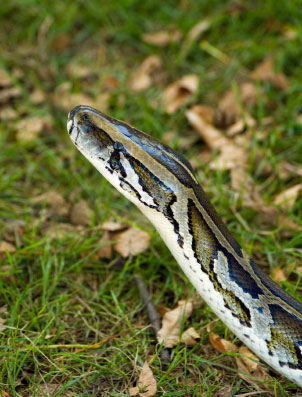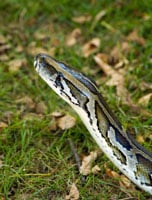USGS study shows possibility of Python molurus bivittatus migrating to coastal areas in Florida.
The Burmese python (Python molurus bivittatus), currently competing with the American alligator as the top predator in the Florida Everglades food chain, can apparently withstand extended times in saltwater, according to a study published in the Journal of Experimental Marine Biology and Ecology. The study, "Experimentally derived salinity tolerance of hatchling Burmese pythons from the Everglades, Florida (USA)" published today and written by scientists Kristen M. Hart, Pamela J. Schofield, and Denise R. Gregoire of the U.S. Geological Survey, involved subjecting 24 wild caught hatchling Burmese pythons from the Florida Everglades to varying levels of saline water. The scientists exposed the snakes to three levels of water types; freshwater with zero salinity, brackish water with a salinity of 10, and full strength sea water with a salinity of 35. All the hatchlings survived about one month at the highest saline levels and five months at the brackish water level.

The Burmese python, an invasive species in Florida, can withstand extended periods in saltwater
The authors surmise that saltwater alone cannot be counted as a barrier to the spread of the Burmese python to surrounding areas of the state, such as the Florida Keys.
"Because reptiles, in general, have poor salinity tolerance, it was hoped that saltwater would naturally hinder pythons' ability to expand their range beyond the Everglades,” Kristen Hart, a research ecologist and the study's lead author said in a press statement released by the USGS. “Unfortunately, our results suggest saltwater alone cannot act as a reliable barrier to the Everglades python population." Prior to the study, it was unknown what factors saltwater would have on the potential spread of the Burmese python outside its current range in Florida, where the snake is primarly found in in the Florida Everglades and surrounding areas. The USGS says that the study shows the possibility that the Burmese python can spread to other areas, one estuary at a time. The study also noted that the python retains similar salinity tolerances to that of the mangrove snake, a species native to the Everglades that has a high tolerance to high saline environments.



